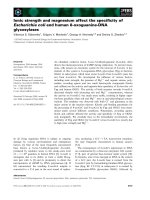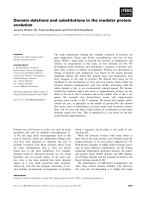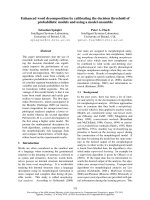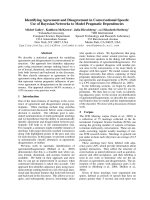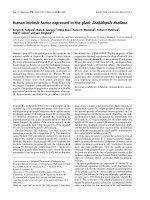báo cáo khoa học: " Placenta increta causing hemoperitoneum in the 26th week of pregnancy: a case report" ppt
Bạn đang xem bản rút gọn của tài liệu. Xem và tải ngay bản đầy đủ của tài liệu tại đây (437.79 KB, 3 trang )
CAS E REP O R T Open Access
Placenta increta causing hemoperitoneum in the
26th week of pregnancy: a case report
Gentian Vyshka
1*
, Nuredin Çapari
2
, Elmas Shaqiri
3
Abstract
Introduction: Placenta increta is a serious complication of pregnancy. We describe a case leading to uterine
rupture associated with massive intra-abdominal hemorrhage.
Case presentation: A 34-year-old Caucasian Albanian woman, gravida 2, para 1, was admitted to the emergency
department of our hospital for acute abdominal pain associated with profound secondary anemia. An
anatomopathological diagnosis of placenta increta destruens was made. An urgent hysterectomy was performed
after resuscitation procedures, applied due to the severe anemia and the abdominal drama accompanying the
case. Intra-operatively, a uterus-saving procedure was found to be impossible, and hysterectomy remained the only
surgical option. The uterine structures were sent for further microscopic evaluation . On histological examination,
deep trophoblastic infiltration of the uterine wall was observed, justifying the surgeon’s decision. Our patient
received blood transfusions and antibiotics. Her sutures were removed on the eighth postoperative day and she
was discharged the following day in a stable condition.
Conclusion: This case, describing a patient with uterine rupture and massive hemorrhage, illustrates a serious and
potentially fatal complication of placenta previa. In such cases, surgery is essential, and hysterectomy may be the
only viable option.
Introduction
Placenta increta is a serious complication o f pregnancy.
It is characterized by entire or partial absence of the
decidua b asalis, and by the incomplete development of
the fibrinoid (Nitabuch’s) layer. Although it is consid-
ered a rare occurrence with a prevalence of approxi-
mately 1 in 2500-7000, it is associated with high
morbidity and sometimes with a lethal outcome, mainly
as a result of severe bleeding, uterine rupture and infec-
tions [1].
Correlations have been suggested with placenta previa,
previous uterine curettage, previous cesarean sections,
multiparity (six or more pregn ancies), and advance d
maternal age [2]. The precise etiology of this condition
remains unclear.
Case presentation
A 34-year-old Ca ucasian Albanian woman was admitted
during the 26th week of her second pregnancy for
severe anemia and diffuse abdominal pain, and with the
suspicion of uterine rupture. She had given birth
14 years previously to a healthy child by caesarean sec-
tion. Her medical history included n o other episodes of
surgery and no internal disease. This second pregnancy
was considered normal by the family obstetrician; two
months before her urgent admission, our patient had
undergone routine sonogra phy, which had given normal
results.
Upon admission, our patient had profound anemia
with a red blood cell count of 1.71 × 10
6
/mL (normal
4 6.2 × 10
6
/mL) and hemoglobin of 5.6 g/dL (normal
11.5-16.5 g/dL). No fetal sounds could be heard, and the
overall state of our patient was deeply compromised
because of the acute and painful abdominal process. Fol-
lowing resuscitation she was sent for emergency surgery
A midline laparotomy was urgently performed, and
approximately 1800 mL of intra-abdominal blood was
drained. A rupture was detected at the left superior
* Correspondence:
1
Biomedical & Experimental Department, Faculty of Medicine, Rr. Dibrës 371,
Tirana, Albania
Full list of author information is available at the end of the article
Vyshka et al. Journal of Medical Case Reports 2010, 4:412
/>JOURNAL OF MEDICAL
CASE REPORTS
© 2010 Vyshka et al; licensee BioMed Central Ltd. This is an Open Access article distributed under the terms of the Creative Commons
Attribution License (http://creativec ommons.or g/licenses/by/2.0), which permits unrestricted use, distribution, and reproduction in
any medium, provided the original work is properly cited.
angle of the uterus; the fetus was dead, and was still
implanted inside the uterine cavity. The fetus was
removed through the wide rupture line (Figure 1). Intra-
operatively, it was considered impossible to save the
uterus, especially in terms of another possible preg-
nancy. Because the quantity of intra-abdominal blood
removed was considerable and the uterine rupture was
considered sufficiently large to prevent a uterus-saving
procedure, the surgeon opted not to use an arterial
ligature.
The uterine tissue was sent for pathologic evaluation.
Trophoblastic islands were found inside the myome-
trium (Figure 2). Fresh red blood cells were found in
the rupture line (Figure 3). Pro gressive and agg ressive
infiltrates of polymorphonuclear lymphocytes were also
found inside the uterine wall (Figure 4).
Our patient received a transfusion of four units of
fresh whole blood (group A, Rh positive), along with
saline perfusions and antibiotics. Two weeks after
the hysterectomy, her red blood cell count was 3.6 ×
10
6
/ml, and the hemoglobin level 11.2 g/dl. The sutures
were removed on the eighth postoperative day, and she
was discharged the next day in a stable situation.
Discussion
The clinical features of placenta increta, such as hemor-
rhage, uterine rupture and inversion, and invasion of the
urinary bladder, are all related to the site of placental
impl antation, the depth of myometrial invasion, and the
width of abnormally adherent placental tissue [3]. Myo-
metrial invasion of trophoblastic islands at the site of a
previous cesarean section may cause uterine rupture
long before the onset of delivery, as in our patient.
Figure 1 Wide uterine rupture.
Figure 2 Trophoblastic islands in the myometrium
(haematoxylin and eosin, original magnification × 40).
Figure 3 Fresh red blood cells in the rupture line
of the uterine wall (haematoxylin and eosin, original
magnification × 160).
Figure 4 Polymorphonuclear lymphocytes infiltrating the
uterine wall (haematoxylin and eosin, original magnification ×
160).
Vyshka et al. Journal of Medical Case Reports 2010, 4:412
/>Page 2 of 3
In these cases, resuscitation procedures (when appro-
priate) and an urgent hysterectomy seem to be the
treatment of choice. P reviously,amoreconservative
treatment, aiming at uterine rescue, was followed, based
upon manual removal of as much placental tissue as
possible. Fox et al. reported that 25% of the women
died during this treatment [4]. Under these circum-
stances, the more c onservative treatment can be
achieved only in cases of a partial placenta accreta/
increta, when bleeding is minimal. Alternat ive interven-
tions include ligature of uterine artery or internal iliac
artery, or angiographic embolization [5].
There are a number of risk factors leading to hemo-
peritoneum during pregnancy. Previous gynecological
procedures, pregnancies, infections and curettage, tro-
phoblastic disease, and endometrial or cervical malig-
nancies favor such an occurrence [6]. Spontaneous
uterine rupture may also follow adenomyosis, instru-
mental termination, manipulations during labor, miso-
prostol-induced labor, or cocaine misuse. In some cases,
no cause can be identified, and these are considered
idiopathic [7-9].
Prenatal diagnosis of placenta increta can be per-
formed using Doppler sonography and magnetic reso-
nance imaging [10]. However, the diagnostic value of
sonography in prenatal diagnosis of an asymptomatic
placenta increta is uncertain. Finberg et al.reporteda
positive predictive value of 78% and a negative predic-
tive value of 94% [11], but other authors suggested that
sonography might detect only around 33% of cases of
placenta accreta/increta [12].
Regarding treatment, hysterectomy is probably the
best option for long-term outcome, as previously
reported [13]. There have been attempts to treat pla-
centa increta with various drugs to allo w the pregnancy
to continue [14]. The most widely used drug is metho-
trexate, although its s afety and the efficacy in this set-
ting are questionable [15,16].
Conclusion
Our pa tient presented with uterine rupture in the emer-
gency department. This case illustrates a serious and
potentially fatal complication of placenta incret a, due to
massive hemorrhage.
Consent
Written informed consent was obtained from our
patient for publication of this case report and accompa-
nying images. A copy of the written consent is available
for review by the Editor-in-Chief of this journal.
Author details
1
Biomedical & Experimental Department, Faculty of Medicine, Rr. Dibrës 371,
Tirana, Albania.
2
District Obstetrical Hospital, Saranda, Albania.
3
Department
of Forensic Pathology, Institute of Legal Medicine, Rr. Dibrës 372, Tirana,
Albania.
Authors’ contributions
GV wrote the paper, checked the medical records and the literature, and
revised the manuscript in accordance with the reviewers suggestions. NÇ is
the surgeon who performed the operation. ESH performed the pathological
sections and microscopic examinations. All authors read and approved the
final manuscript.
Competing interests
The authors have no competing interests hereby to declare. No funds were
granted to support the present study.
Received: 23 February 2010 Accepted: 22 December 2010
Published: 22 December 2010
References
1. Berchuck A, Sokol RJ: Previous cesarean section, placenta increta, and
uterine rupture in second-trimester abortion. Am J Obstet Gynecol 1983,
145:766-767.
2. Miller DA, Chollet JA, Goodwin TM: Clinical risk factors for placenta
previa-placenta accreta. Am J Obstet Gynecol 1997, 177:210-214.
3. Haynes DI, Smith JH, Fothergill DJ: A case of placenta increta presenting
in the first trimester. J Obstet Gynaecol 2000, 20:434-435.
4. Fox H: Placenta accreta, 1945-1969. Obstet Gynecol Surv 1972, 27:475.
5. Liu X, Fan G, Jin Z, Yang N, Jiang Y, Gai M, Guo L, Wang Y, Lang J: Lower
uterine segment pregnancy with placenta increta complicating first
trimester induced abortion: diagnosis and conservative management.
Chin Med J 2003, 116:695-698.
6. Yang JJ, Xiang Y, Wan XR, Yang XY: Diagnosis and management of
uterine arteriovenous fistulas with massive vaginal bleeding. Int J
Gynaecol Obstet 2005, 89:114-119.
7. Berghahn L, Christensen D, Droste S: Uterine rupture during second
trimester abortion associated with misoprostol. Obstet Gynecol 2001,
98:976-977.
8. Mishra A, Landzberg BR, Parente JT: Uterine rupture in association with
alkaloidal cocaine abuse. Am J Obstet Gynecol 1995, 173:243-244.
9. Sallam AH, Preston J: Idiopathic uterine perforation in late pregnancy.
J Obstet Gynaecol 2002, 22:317.
10. Gielchinsky Y, Rojansky N, Fasouliotis SJ, Ezra Y: Placenta accreta-summary
of 10 years: a survey of 310 cases. Placenta 2002, 23:210-214.
11. Finberg HJ, Williams JW: Placenta accreta: prospective sonographic
diagnosis in patients with placenta previa and prior cesarean section.
J Ultrasound Med 1992, 11:333-343.
12. Lam G, Kuller J, McMahon M: Use of magnetic resonance imaging and
ultrasound in the antenatal diagnosis of placenta accreta. J Soc Gynecol
Investig 2002, 9:37-40.
13. Suner S, Jagminas L, Peipert JF, Linakis J: Fatal spontaneous rupture of
a gravid uterus: Case report and literature review of uterine rupture.
J Emerg Med 1996, 14:181-185.
14. Crespo R, Lapresta M, Madani B: Conservative treatment of placenta
increta with methotrexate. Int J Gynecol Obstet 2005, 91:162-163.
15. Kayem G, Davy C, Goffinet F, Thomas C, Clement D, Cabrol D: Conservative
versus extirpative management in cases of placenta accreta. Obstet
Gynecol 2004, 104:531-536.
16. Liao CHY, Ding DCH: Failure of conservative treatment for placenta
increta. Taiwan J Obstet Gynecol 2009, 48:302-304.
doi:10.1186/1752-1947-4-412
Cite this article as: Vyshka et al.: Placenta increta causing
hemoperitoneum in the 26th week of pregnancy: a case report. Journal
of Medical Case Reports 2010 4:412.
Vyshka et al. Journal of Medical Case Reports 2010, 4:412
/>Page 3 of 3

